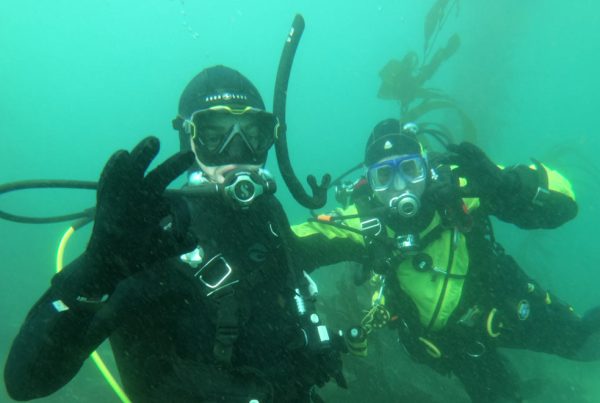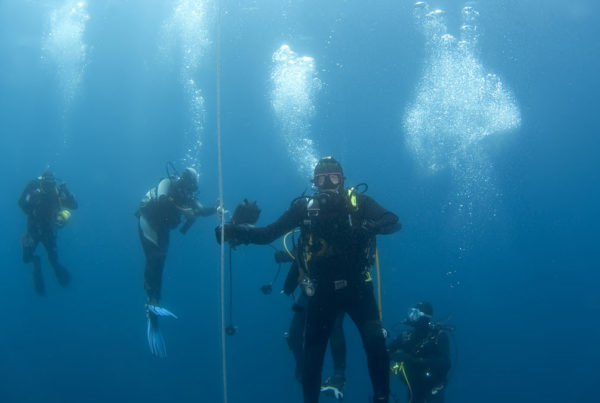Water clarity (visibility) seems to be very important to divers, even inappropriately so at times. Divers speak with glee when the “viz” is in triple digits. I heard it once said that the reason the water is so clear is there is nothing in it—there is no life in it. While a lot of things make for clear water, or lack thereof, marine life is probably the most important and least understood and it is what affects water clarity in the most profound way in California.
By marine life we are not talking kelp or fish, although an abundance of these can most certainly bring visibility to zero in a hurry. I am talking about microscopic marine life—plankton, zooplankton and the like. These microscopic plants and animals cloud water, make it green (and in some cases red) and water clarity drops. But an abundance of plankton is a good thing. As you probably know, this is the basis of the food chain. Small animals feed on the microscopic plants and animals and larger animals in turn feed on the small animals and so on. The more plankton, the more food and more animals.
Plankton are the most abundant when nutrients and sunlight are abundant. The nutrients come from two main sources: runoff and upwelling. Deep waters are full of nutrients. When they are pushed (or pulled) to the surface the effect is known as upwelling. Rainwater runoff from land is also rich in nutrients, although not as pure as deep water upwelling. The third component, sunshine, warms the water and provides the energy the microscopic plants need to thrive. It is not a whole lot different than your garden; fertilizer (the nutrients) and sunshine and your garden grows (in the ocean, of course, water is abundant).
It is for these reasons that visibility is at its poorest in the spring. Rainwater runoff from winter and spring storms already dirty the water but the nutrients feed a plankton population that is getting an ever increasing dose of sunshine.
Upwelling can occur any time of year, but is most prevalent late fall and early winter. With diminished sunshine at this time, plankton growth is held in check. Actually, this the best time for good water clarity in California because this cold water upwelling from the depth is usually very clear. Areas near deep drop-off or submarine canyons benefit from deep water upwelling.
Runoff, mainly from rain, always contain sediment amongst other crud. Waters around the islands are not immune to this contamination but the effect is generally much lighter. The closer your dive site is to run off point, the worse the problem. Some site clear out quickly, just a day or two, others slower, depending on various factors.
A water clearing factor is oceanic currents. Waters far offshore are cleaner than nearshore waters. There is lack of contaminating runoff but also oceanic currents whisk away dirt and sediment. Offshore pinnacles, reefs and islands benefit greatly from this effect but mainland rocky points also benefit if the currents come close enough to shore. Some popular points along our coast that get the benefits of these currents are the Monterey Peninsula, Point Dume, Palos Verdes, and Point Loma.
Anything that stirs up the bottom is going to drop visibility. Most common water agitator is surf and surge. If you want clear water, dive in calm waters. But another factor not always talked about is other divers (or even yourself). Divers are notorious for stirring up the bottom or knocking loose sediment resting on kelp fronds. Practice good buoyancy control, stay up off the bottom when ever possible and if you settle down to the bottom, do so, knees or chest first. If you want to avoid the bad effects of other divers, just keep clear of the crowd.
Rip currents are when surf flows up on a beach then finds the path of least resistance back to the sea through a trough in the sand. Flow of water and debris can be profound. The water flow can be dangerous to the unaware, but it also can affect water clarity offshore adversely.
When planning a dive, particularly a beach dive, try to hit it at high tide (depending if the site is conducive to a high tide dive). The clearest waters are those offshore. High tide pushes these clearer waters closer to shore. While the effect is not significant, it is nice to have a few extra feet of visibility.
Where the effects of tides does become significant is bays or near the mouth of a bay. Water clarity is generally not good in bays. With an outgoing tide, this dirty water is dumped to nearby dive sites. Also, an incoming or high tide can improve viz within a bay. (Sidenote: If you are diving in or near the mouth of a bay, be aware that tidal currents can become dangerously powerful. Plan accordingly.)
And finally, air bubbles can zero out visibility. A “white-out” does not just apply to driving in the snow, it can be a problem in diving as well. If you head up into shallow water in the surf the intense sloshing and churning can aerate the water with thousands of tiny bubbles. While this is a short term problem, the zero visibility can disorientate a diver long enough to be dangerous. Avoid such areas if you are not comfortable with such a prospect.










